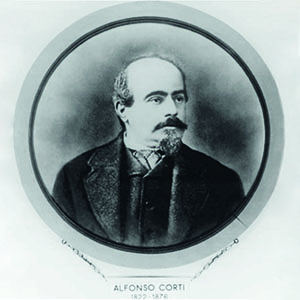ALFONSO CORTI: L’UOMO, LA VITA, LE OPERE
DOI:
https://doi.org/10.4081/lettere.2022.810Abstract
ABSTRACT. – Marquis Alfonso Corti di Santo Stefano Belbo, descendant from a rich and noble family of Lombardy and Piedmont, described for the first time, in 1851, a series of cellular structures of the inner ear, basic for the auditory function, now known as “Corti’s organ”. Corti, born in Gambarana near Pavia on June 25, 1822, enrolled in 1841as a medical student at the University of Pavia. Here his favorite study was microanatomy, under professors Bartolomeo Panizza and Mauro Rusconi. In 1845, Corti moved to Vienna to complete his medical studies and to work at the Anatomical institute of the University under the supervision of professor Joseph Hyrtl and in August 1847 received the degree in medicine, with a thesis on the cardiovascular system of a lizard, the Psammosaurus griseus. At the end of December 1847 Corti was chosen as Hyrtl’s second prosector, but he soon had to relinquish this position. With the outbreak of the 1848 Revolution he left Vienna and, after a brief military service in Italy, from February to August 1849 was in Bern, where he began his own-microscopic studies in collaboration with the physiologist Gustav Gabriel Valentin. Except for a trip to England, where he met some important microscopists, Corti spent the rest of 1849 with his relatives in Paris, working at the Institute of Anatomy of the Sorbonne. In the middle of January 1850, Corti left for Wurzburg Institute of Anatomy, directed by Albert Kölliker, where he began to work on the mammalian auditory system. In August 1850 Corti spent a short time at the Observatorium microscopicum in Utrech, then he returned to Würzburg and later to Paris, to complete his study of at least 200 cochleas of man and different animals. His famous paper, “Recherches sur l’organe de l’ouie des mammiferes”, appeared in 1851 in Kölliker’s journal Zeitschrift für wissenschaftliche Zoologie. After the publication Corti left Paris for Turin where he had to interrupt his scientific work in order to deal with the division of his father estate. Suddenly and inexplicably, Corti gave up any scientific activity and disappeared from the scientific world. In 1855 Corti married Maria Bettinzoli, lady of noble birth, who presented him with a daughter Bianca, and a son Gaspare, but in 1861 she died, leaving him with the responsibility of rearing the children. Corti spent the rest of his life as a country nobleman and selected winegrower in his Villa Mazzolino in Corvino San Quirico near Casteggio, soon restricted in his mobility due to a severe arthritis deformans, and died in Corvino on October 2, 1876. After Corti brought his relations with his anatomist colleagues in 1854, his stature began to fade. During the second half of the 19th century, Corti’s Recherches were cited more and more in articles and treatises on otology, but the memory of their author has been lost. Corti passed like a meteor in the scientific world of the mid 19th century and it was only at the beginning of the 20th century that some researches began to wonder about the man behind the name of Corti’s organ.
Downloads


